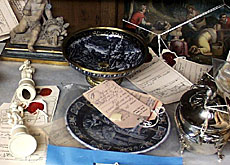Suspected art thief takes the stand

The trial of a French man suspected of stealing more than 200 works from museums across Europe is under way in canton Fribourg.
Legal proceedings are being conducted in Switzerland because it was here that Stéphane Breitwieser began his notorious career.
On the first day of his trial, Breitwieser described his first foray into thieving at the 11th-century Gruyères Castle.
“I was fascinated by the beauty, the qualities of the woman [on the portrait], by her eyes, which reminded me of my grandmother. It looked a lot like a Rembrandt,” he told the court in the town of Bulle.
“It was the first time, and I thought about it for ten minutes before stealing it,” Breitwieser added.
It was the start of a thieving spree spanning seven years during which the native of Alsace allegedly amassed 239 objects including paintings by Peter Brueghel, Antoine Watteau and François Boucher.
The most valuable piece stolen is believed to be a 16th century painting by Lucas Cranach the Elder, worth between $8 million and $9 million.
His life of crime came to an end with his arrest in November 2001 after stealing a 400-year-old bugle from the Richard Wagner Museum in Lucerne.
It was thought to be his 174th theft.
Breitwieser is accused of stealing 69 paintings worth more than SFr1 million ($730,000) from museums in 16 Swiss cantons.
Once the proceedings against him in Switzerland are concluded, he is due to be extradited to France for a second trial.
Breitwieser is thought to have been active in France, Belgium, Germany, Netherlands, Denmark and Austria.
Modus operandi
Breitwieser worked discretely during opening hours, targeting items that he liked.
Most of the plunder consisted of works from the 17th and 18th centuries, and he tended to steal pieces small enough to be stashed in a rucksack or hidden under a overcoat.
Breitwieser often used a pocket knife to remove paintings from their frames, taking care not to damage the precious loot.
Sometimes, however, he would steal objects for which he had no affection, and these he subjected to an unhappy fate, either destroying them or throwing them away.
Art lover
While Breitwieser’s pinching spree lasted almost seven years until 2001, it seems he was not motivated by money.
He kept the works of art in his home near the French town of Mulhouse, just over the border from Basel, which he shared with his mother.
He took a great interest in his private collection, spending time in libraries and with specialists to learn more about the things he had pilfered.
Breitwieser also took care of his booty by carrying out restoration himself or by using an expert.
In one case, he paid SFr1,500 to a watchmaker to repair a timepiece he had stolen from a museum in canton Aargau in northern Switzerland.
Running in the family
Breitwieser has claimed that his family were responsible for his hunger for antiques.
He was brought up in a home stuffed with objets d’art inherited by his father.
After his parents’ marriage ended in divorce, his father, on quitting the marital home, refused his request to leave him part of his antique-weapons collection.
Breitwieser says this was the fuse that lit the fire.
His robbing career had a curious effect on his mother.
Mireille Breitwieser confessed to having destroyed or thrown away a large part of her son’s collection in a fit of anger at the news of his arrest in November 2001.
She put out priceless items either for the rubbish collectors or dumped them in the Rhine-Rhone canal.
She also reportedly cut up works by Brueghel and Watteau.
Media reports at the time said she had destroyed $1.4 billion (SFr1.9 billion) worth of art.
Spotlight on security
The case was seen as an indictment of the inadequate security at many museums and art galleries across Europe.
Hans Furer, secretary of the Swiss Galleries Association, told swissinfo that many museums and galleries simply cannot afford the often prohibitive costs required to provide security for individual works of art.
“Security is enormously expensive and [many] museums have enough difficulty finding the money for exhibitions [alone],” said Furer.
He added that the level of security devoted to any one object was very much dependent on its financial value, especially for smaller establishments with limited resources.
“You couldn’t steal the golden bust of Marcus Aurelius in the museum in Avenches,” he said.
“The security is very tight because the value of this object is enormous. But you have many objects which are of lesser value and there is consequently less security for these objects.”
Furer stressed that issues of cost and security were problems for museums and galleries all over the world and not just those in Switzerland.
A verdict is expected on Thursday.
swissinfo with agencies
Stéphane Breitwieser is on trial for stealing 69 works of art in Switzerland.
Breitwieser is said to have stolen 239 items from European museums.
He stole for pleasure not profit, amassing a private collection in France.

In compliance with the JTI standards
More: SWI swissinfo.ch certified by the Journalism Trust Initiative









You can find an overview of ongoing debates with our journalists here . Please join us!
If you want to start a conversation about a topic raised in this article or want to report factual errors, email us at english@swissinfo.ch.